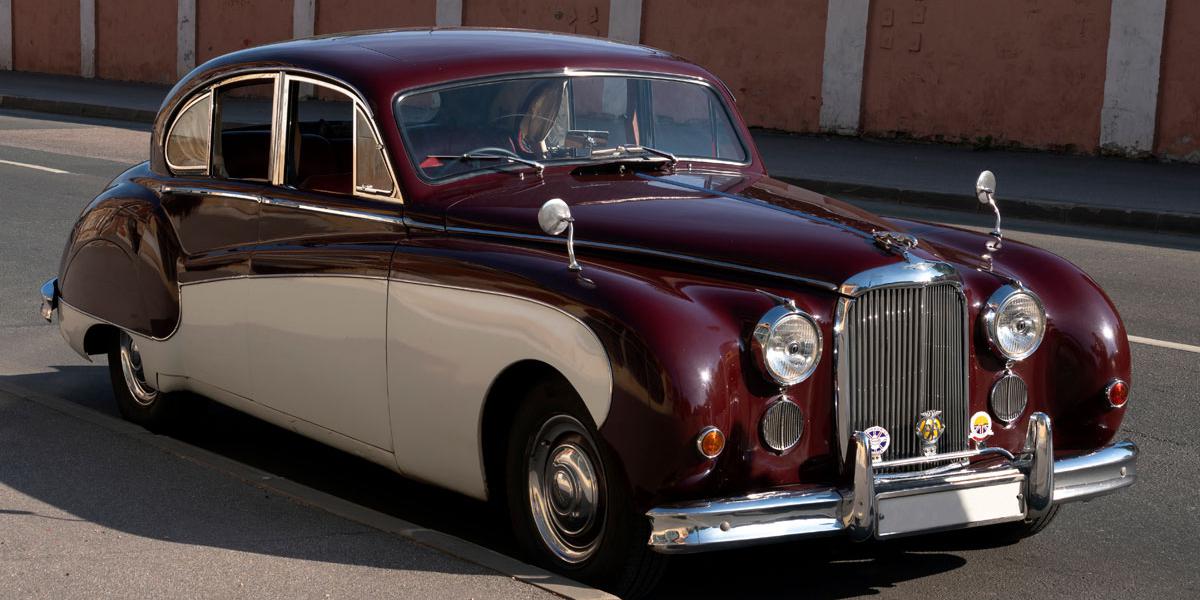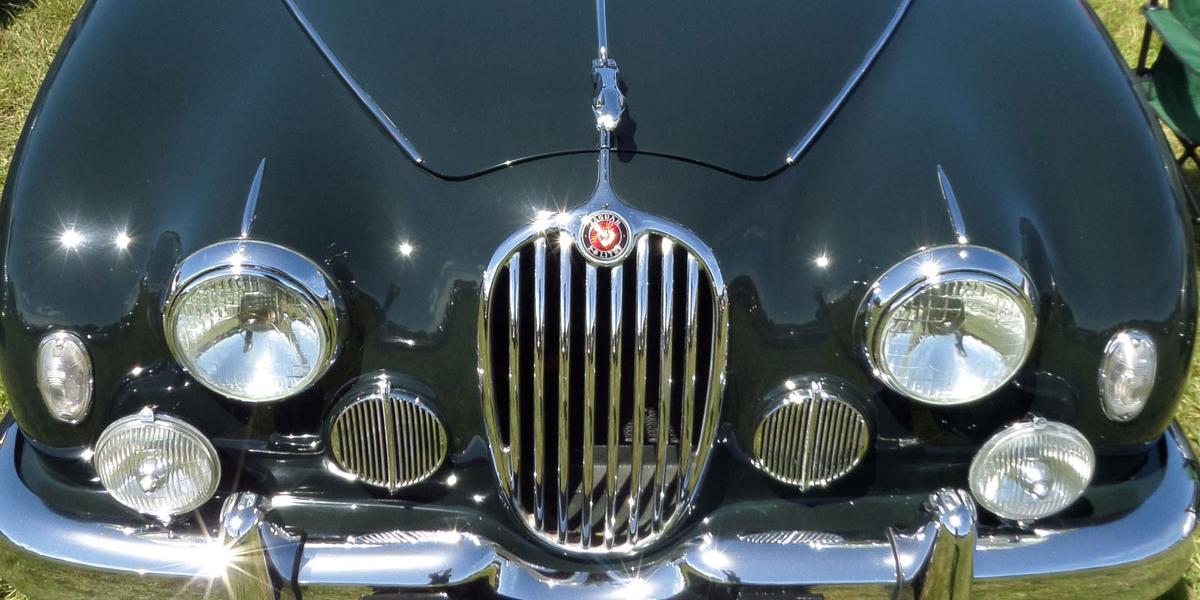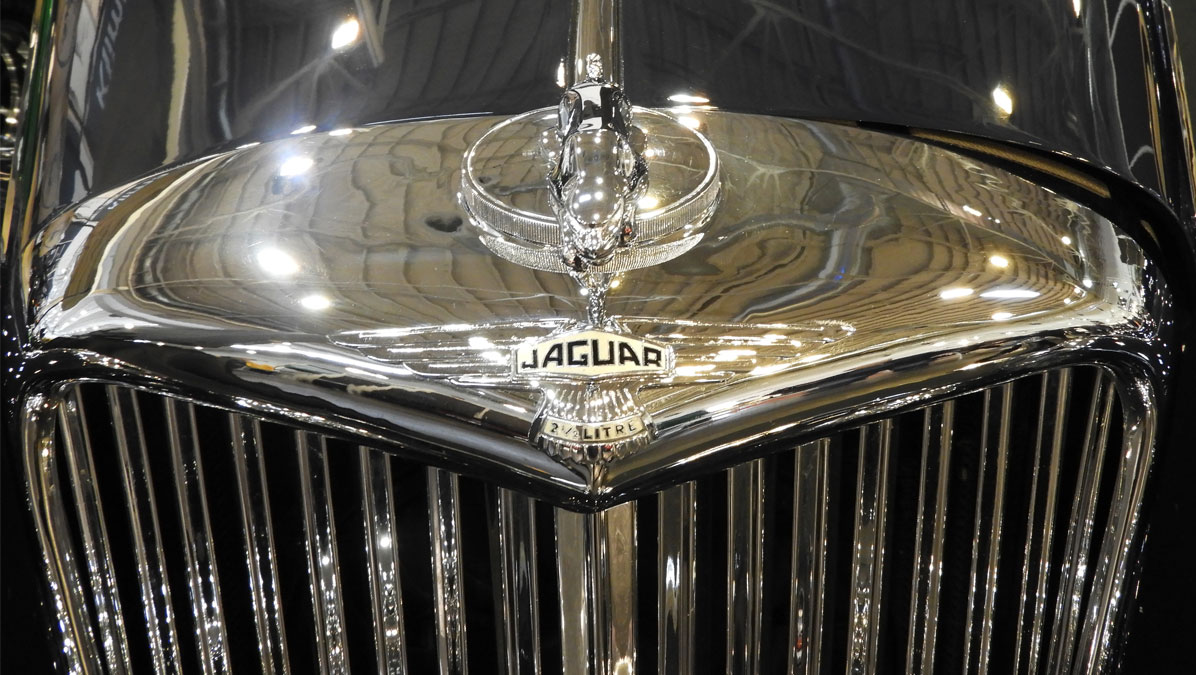Above: The 1948 steel body Jaguar IV 2.5 Litre Saloon powered by the in-house 102 bhp 6-cylinder engine
Endeavour Morse - Jaguar 2.4 Litre Mark 1
28 February, 2024
KAN169 as driven by Shaun Evans and Roger Allam in the Oxford based detective series is a Jaguar 2.4 litre first registered on 19 April 1956.
The Jaguar 2.4 retrospectively became known as the Mark 1 only when the Mark II was released in 1959.
Available as a Standard or Special addition E KAN 169 was the SE. Both versions had leather upholstery and the opulent walnut dash which had the tacho and speed dials mounted centrally which was a shrewd cost saving for the LHD export market.
Of course, the Black Jaguar 2.4 that was first registered on 19 April 1956 did not, whilst being driven around the streets of Oxford, require an annual MOT nor indeed taxing, enjoying that elevated status, on the basis that no substantial changes had been made to the vehicle in the last 30 years and that it was first registered (as opposed to built) more than 40 years ago.
It's one thing owning and driving a classic car and another for those whose skill sets and enthusiasm do not quite extend to spending time under the bonnet to ensure it's roadworthiness.
What you might save on the annual MOT cost of £54.85 which gives you, apart from an MOT certificate, that all essential peace of mind and probably a heads up on some future required expenditure, might pale in contrast to a fine of up to £2500 if it's roadworthiness was subject to a real life challenge.
In Endeavour the prequel to Inspector Morse, Shaun Evans plays the young Detective Constable Morse driving the Black Jaguar 2.4 litre Mk1, and it was the Burgundy Jaguar 2.4 MK2 registration 248 RPA that was driven by Inspector Morse (John Thaw) that is seen in the last episode as the two characters pass each other on the road, signifying the passing of the baton for viewers to re-watch the Inspector Morse series, which originally ran from 1987 to 2000.
Whether or not Shaun Evans knows this, I suspect not, but the 2483cc Jaguar registration KAN 169 makes its debut very briefly in the first episode of the final series 9, eight seconds into the 13th minute.
Series 9, with just 3 episodes is the last of the "Endeavour" series which first aired on 26th February 2023 and is now set 1972 approaching the overlap with the Inspector Morse series.
The pre-quel Series one first aired as a pilot in 2012, set in the June of 1965 and the last episode aired in March 2023.
The 2.4 litre Mark 1 is newsworthy (as most Jaguars are...to be fair)
Launched in September 1955 and followed by a 3.4 litre engine in 1956 it was a unitary body construction (sometimes referred incorrectly as a monocoque, but at the very least a semi-monocoque).
The monocoque unibody (which nearly every production car uses nowadays) car is where you have effectively all in one super strong shell with internal structures and supports with all the engine and drive train etc mounted into it with independent suspension for all 4 wheels.
What is newsworthy is that the unitary body construction costs a fortune and is only geared to high volume production to get a return on investment.
The volume involved for this had never been achieved before by Jaguar. If the fickle public did not like the design, if the marketing was not up to scratch......if the competition pulled a rabbit out of the hat with a price to match?
It's probably also true, that there was no real alternative other than to progress.
So the investment for designing and developing the 2.4 saloon was, for the launch in 1955, 1 million pounds which nowadays in 2024 equates to a mere inflation adjusted £32.8 million.
In Hindsight it seems like it could almost be made into a film..
There are a lot of positives, the wartime years had been spent working on airplane component production and repairs.
SS Cars worked on the De Havilland Mosquito, Lancaster Bombers, Supermarine Spitfire and parts ranging from auxiliary fuel tanks and wing-tips for the Spitfire; bomb-bay doors for the Lancaster, as well as trailers, and motorbikes with sidecars also destined for the armed forces, which was the original product manufactured by messers Walmsley & Reynolds at the Swallow Sidecar Company when they started in business in 1922.
During the Second World War (WWII) no private cars, commercial vehicles or vehicle parts were made in the UK as all vehicle manufacturing was utilised to arm the military.
After the war, SS Jaguar vehicles that had been in production , such as the SS Jaguar 1.5 litre, 2.5 litre and 3.5 litre were updated and rebadged as the Jaguar Mark IV 1.5, 2.5 and 3.5 litre under the new company name Jaguar Cars Ltd, distancing itself from any perceived connotations, that "SS" might evoke however tenuous, with SS Cars Ltd which had evolved from the Swallow Sidecar Company.
Jaguar MK-IX
 The Queen Mum's Jaguar VII was upgraded to be externally identical to the IX
The Queen Mum's Jaguar VII was upgraded to be externally identical to the IX
Silverstone
 Silverstone Racing Circuit 2018
Silverstone Racing Circuit 2018
It's 1954- 55
The XK engine and XK120 sports car had reaped huge interest at home and abroad and the Mark V Saloon though overshadowed by the XK120 at the 1948 International Motor Show had outsold it year on year.
The Mark V was superseded in 1950 at Earls Court Motor Show by the luxuriously appointed Jaguar VII.
The car was designed to appeal to the American market offering style, size, comfort and the 3442cc sized XK engine that would deliver 100mph and so it generated $30m million dollars of orders in the first few months and Jaguar, not for the first time had the coveted title of “fastest production saloon car in the world”
Even the Queen Mum bought one
On top of that Factory-entered Mark VIIs won the Daily Express International Trophy Production Touring Car race at Silverstone five years running, and twice took the top three places.
The Silverstone Jaguar VII Period
Stirling Moss won in 1952 and 1953 with Ian Appleyard in 1954, with Tony Rolt and Stirling Moss in 2nd and 3rd places, then Mike Hawthorn in 1955, with Jimmy Stewart and Desmond Titterington in 2nd and 3rd and Ivor Bueb in 1956, Duncan Hamilton in a Jaguar 2.4 litre taking 3rd and Belgian Paul Frère taking 4th in a VII.
Jaguar dominated Silverstone for a decade
Jaguar would be seen to dominate at Silverstone every year until 1963 attaining top 3 positions in 1957, and 58. Then taking top 6 positions driving the Jaguar 3.4 litre in 1959, followed by the top 3 positions in 1960, 1961 and 1962 driving the Jaguar MK II 3.8 litre.
Jaguar annual production from 1946....
In 1946 Jaguar Cars produced 142 RHD vehicles those being the Mark IV 1.5 litre powered by a Standard Motor Company 1776 cc engine.
In 1947 this increased to 2930 consisting of 1765 1.5 litre, 427 2.5 litre and 738 3.5 litre all of them RHD saloons.
In 1948 the Mark IV DHC was introduced and together with the 1947 model range and including 1047 LHD the tally climbed to 5405 vehicles.
In the October/November of 1948 the XK120 and the Mark V were unveiled at the International Motor Show at Earls Court London, but steel for making cars was a scarce commodity and petrol rationing set to continue until 1950.
In 1949 the total of 3565 LHD vehicles saw the end of the Mark IV range.
In 1950 the total rose to 3982 as the XK120 OTS, the Mark V 2.5 and 3.5 litre saloon, and the 2.5litre Drop Head Coupé came online with a 75% RHD & 25% LHD split
In 1951 with same vehicle range and a few LHD Mark VII Saloons it hit 8141 with a 66% RHD & 34% LHD split
...through to 1955
In 1952 The Mark V was superseded by the Mark VII, there was no Mark VI, there being a Daimler VI.
The XK120 FHC came online with a total of 5522
In 1953 the product range was the same with a few XK C-Type totalling 9074.
It was a 36% RHD & 64% LHD as the American demand for the XK 120 (OTS & FHC) and the MK VII 3.4 litre Saloon started to kick in.
In 1954 the Total was 16842 with the XK120 DHC coming online.
Out of the XK 120 range 90% went abroad whilst domestic demand for the MKVII 3.4 litre was more than double than that of the export.
In 1955 production was at 3224 with the advent of the XK140 in OTS, FHC and DHC formats.
The XK120 was no more, some XK D-Types were produced and a small number of the Jaguar 2.4 Mk I "monocoque chassis-less compact saloon"since the launch on 28th September of the same year and the VII M Saloons replacing the VII.
 The Jaguar 2.4 litre launched in 1955 came in Standard and Special editions. The former lacked, among other things, the Jaguar mascot on the bonnet.
The Jaguar 2.4 litre launched in 1955 came in Standard and Special editions. The former lacked, among other things, the Jaguar mascot on the bonnet.
The Jaguar 2.4 litre launch in 1955 at Earls Court
The 1955 Jaguar 2.4 litre launch at London
The press were ecstatic initially and even moreso when they actually got their hands on one to test drive it in the Summer of 1956
William Lyons design of the Jaguar 2.4 litre perpetuated a strong family resemblance with the XK120 coupé and the large MK VII and revived the post war notion of the sports saloon.
It had a top speed of 101.5 mph, could do 0-60mph in 14.4 seconds and had a fuel consumption of 18.3 mpg
It was launched in the September of 1955 complete with whitewall tyres and spats concealing the rear wheels, but would not actually be available until 1956.
Jaguar Options - who wouldn't?
In case you wanted to extract more performance from your 2.4 you could opt for one of three tuning kits to enhance the power from 112bhp to 119bhp, 131bhp and 150bhp respectively.
Quibbles, Criticism?
Yes....The 4 wheel drum brakes, which would evolve to 4 wheel disc brakes as an “option” in 1957 and would also be available as a conversion kit to change drum braked cars to disc braked.
The 3.4 litre Mark 1 available from 1957 would feature for a very short time with drum brakes and then disc brakes as standard.
And so to the critics reviews...
It would be remiss of me not to add in extracts from motoring weeklies of the day, where the language used is as pleasurable to read as is the content of the same, the first being from "The Motor" published in the 25th July 1956 issue as follows:
"more than one member of our staff found that a few miles were needed before the car aroused his fullest enthusiasm"
And :
"Once the mental adjustment is made the Jaguar becomes very likeable every minute",
In respect of the 2483cc XK engine (which was more a 2.5 litre than a 2.4 if you think about it) it was described as "delightfully smooth and silent" and from a handling perspective (with hub brakes x 4) "the car has no vices and feels equally safe and controllable on a slippery road"
Finally, in respect of the 5 seat leather upholstery and burled walnut topped door panels and drivers facia "the surroundings border on the luxurious"
Indeed..unstinted luxury
The Autocar published the following in the 21st September 1956 issue:
“The 2.4 is one of those cars whose capabilities are appreciated as the mileage amounts. It is quietly very efficient indeed, providing unstinted luxury, fine performance and roadworthiness, and it is offered at a remarkably low price for the high standards and quality construction for which the make is internationally respected.”
And furthermore relative to the all important noise and vibration from the engine:
‘Mechanical smoothness is matched by the silence of the engine.
When accelerating on test runs at full throttle from a standing start, whipping into each higher gear in turn as the rev counter needle touches the red band, high speeds are reached without the slightest mechanical fuss and, although the engine note can be heard, it has a sweet and subdued note… The immunity of the occupants from noise initiated by road surfaces is quite astonishingly good.’
A35 runs roughshod over Jaguar Mk I at Silverstone..
1956
1935 - 1950 The Pushrod Cars with Standard 6-cylinder engine
Jaguar IV 1.5 litre saloon weighed 953 KG
Jaguar IV 1.75 litre saloon weighed 1202 KG
Jaguar IV 2.5 litre saloon weighed 1451 KG
1948 - 1951
In House Pushrod Overhead Valve 6-cylinder engine
Jaguar V 2.5 litre saloon weighed 1451 KG
Jaguar V 3.5 litre saloon weighed 1474 kg
1950 - 1954
XK 3,443 cc
Jaguar VII 3.4 litre saloon weighed 1565 KG
1954 -1956
Jaguar VIIM 3.4 litre saloon weighed 1576 kg
1955 - 1959 launch (1956 in reality) - new chassis-less Unitary car body
XK 2,483 cc
Jaguar 2.4 litre saloon weighed 1225 kg
XK 3,442 cc
Jaguar 3.4 litre saloon weighed 1293 kg
Onwards and upwards
Like for like the chassis-less 1956 Jaguar 2.4 Litre weighed 226kg less than the 1948 Jaguar IV 2.5litre.
The 1957 Mark I Jaguar 3.4 litre weighed 283Kg less than the 1954 Jaguar VIIM 3.4 litre.
Production of the 2.4 litre Mark I as it became known, though launched in 1955, did not start production of any note until 1956 with the 3.4 litre starting in 1957.
Jaguar Cars Ltd manufactured 37,398 Mark I 2.4 and 3.4 litre cars in three years.
The Mark II contributed 84,000 over an eight year period from 1959.
The MK VIIM, MKVIII and IX were adding to the numbers and the E-Type was on the horizon.
In 1956 William Lyons became “Sir William Lyons” and in March the Queen visited Browns Lane Factory.
Jaguar won the 1956 Monte Carlo Rally and Le Mans 24hrs.
The future looked bright.
By 1966 Jaguar post war exports would reach £200 million.
